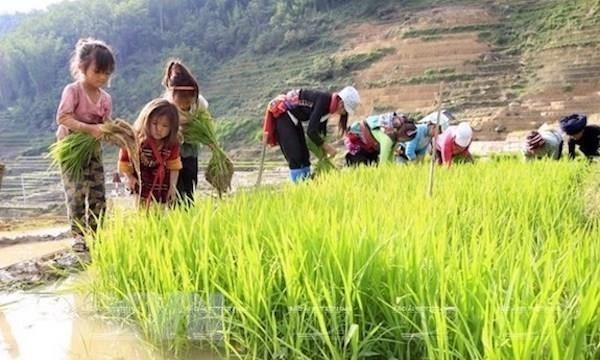Hanoi (VNA) – Children need to be protected from child labour more than ever amidst serious impact of the COVID-19 pandemic, heard a virtual interactive panel discussion jointly held by the Ministry of Labour, Invalids and Social Affairs, the International Labour Organisation (ILO) and the UN Children Fund (UNICEF) in Hanoi on June 12.
The event was livestreamed on Facebook fanpages of ILO Vietnam and UNICEF Vietnam and the portal of National Hotline for Child Protection 111 in response to a global appeal for action on the World Day Against Child Labour (June 12).
Risk of child labour increase due to COVID-19
A new ILO-UNICEF brief indicates that the crisis could lead to the first recorded rise in child labour after 20 years of progress. According to the paper “COVID-19 and child labour: A time of crisis, a time to act”, child labour decreased by 94 million since 2000, but that gain is now at risk.
An estimated over 1 million children between 5-17 years of age are already engaged in child labour in Vietnam, more than half of them in hazardous work. As the pandemic wreaks havoc on family incomes, these children are now at even greater risk of working longer hours or under worsening conditions.
“Immediate actions must be taken to protect children from child labour and to uphold national efforts to prevent and eliminate child labour,” said ILO Vietnam Country Director Chang-Hee Lee. “Social protection plays a significant role in times of crisis as it provides assistance to the most vulnerable.”
The joint ILO-UNICEF paper cites a combination of factors that can contribute to child labour. Vulnerable population groups, such as those in the informal economy and migrant workers, will suffer the most from economic downturn, increased informality and unemployment, the general fall in living standards, health shocks and insufficient social protection systems.
According to the brief, COVID-19 could result in a rise in poverty and therefore to an increase in child labour as households use every available means to survive. Some studies show that a one percentage point rise in poverty leads to at least a 0.7 percent increase in child labour in certain countries.
There remain many things to do
The ILO estimated in April that between 4.6 and 10.3 million workers in Vietnam may be affected by the pandemic. Of concern to UNICEF is increasing evidence that many children did not return to school when they reopened in May this year.
 Virtual interactive panel discussion held in response to World Day Against Child Labour (Photo: VietnamPlus)
Virtual interactive panel discussion held in response to World Day Against Child Labour (Photo: VietnamPlus)“Children, who are trapped in child labour, are deprived of a childhood, their health is at risk, their opportunity to escape poverty is lost and their exposure to other child protection risks increases. In dropping out of school, they are embracing a small payment today but risking lifelong poverty,” said Rana Flowers, UNICEF Representative.
“I know from speaking with schools, particularly in rural areas, that some children have simply not returned. Those children are aged just nine or ten years and they are now working full time. This is hazardous, and it makes them more vulnerable to other protection concerns, including trafficking. UNICEF believes that effective action against child labour in the current context requires that children in the poorest families be placed at the centre of the COVID-19 Social Protection response, and that their protection be prioritised by local authorities who need to actively trace and get them back to school”, she added.
A rapid assessment on COVID-19 impact on child labour is being carried out nationwide with support from the ILO, which will inform the upcoming National Plan of Action to prevent and reduce child labour for the 2021-25 period.
Significant progress has been achieved in the fight against child labour over the years. However, much needs to be done to achieve Sustainable Development Goal Target 8.7 to eliminate child labour by 2025.
“The impacts of COVID-19 on child protection and child labour will be assessed by the Ministry of Labour, Invalids and Social Affairs and other concerned ministries. This assessment will help us to develop the next Plan of Action and a roadmap to reduce child labour by 2025 and forced labour by 2030. I hope we can take steps to work together, especially during the International Year on the Elimination of Child Labour, in order to reduce the obstacles created by the COVID-19 pandemic. By doing so all countries can move towards the achievement of Target 8.7 of the Sustainable Development Goals by 2030,” said Dang Hoa Nam, Director of the Department of Children’s Affairs at MoLISA./.





























